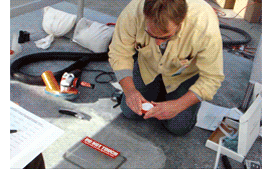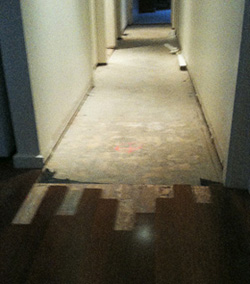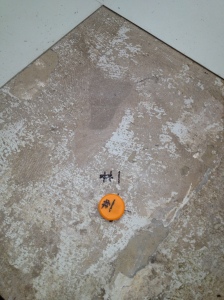In a previous post we discussed the issue of concrete subfloor testing prior to installation. Some of the grey areas in testing have been ironed out with the release of the new resilient flooring standard AS/NZS 1884. While it may not be a “Timber Flooring” standard per se, it is still indicative of industry best practice and highly relevant. Another relevant flooring standard is the Carpet Installation AS/NZS 2455.
It’s widely accepted that US-based research is the most credible. Massive groups like the Portland Cement Institute, CTL Group, and the International Concrete Repair Institute have invested heavily in research, in response to what they dub the “billion dollar problem”, of moisture-related flooring failures.
 (Pic Courtesy of Peter Craig/ Concrete Construction.net)
(Pic Courtesy of Peter Craig/ Concrete Construction.net)
The most recently updated AS 1884 (2012) references and draws from this largely US-based science. More on that later.
Firstly, what about the old “Moisture Meter” capacitance test? They are simple. The Meters were readily available, a little pricey perhaps, but easy to use. You just pop the thing on the concrete surface and voila, it gives you a percentage. The Standards once stipulated that a “moisture content” of less than 5.5% was acceptable to apply floor coverings, and indeed many manufacturers specified this in their spec sheets (and some still do).
But how many contractors or installation shops actually did this test and documented the findings in a way which could be referenced later if needed? According to our findings, not many.
Well, that’s pretty irrelevant now, as the research has indicated serious shortcomings in the simple “moisture content” test. Pages have been written, but we’ll try and summarise it thus: Moisture Meters only measure the top few mm of concrete via electrical resistance, and give you a percentage of water in the area measured.

It turns out that this measurement does nothing to indicate what kind of vapour drive will occur when you slap a semi/non-permeable surface over that concrete, that is, a floor covering.
Other issues, such as increased use of fly ash in concrete have been known to skew resistance meter readings.
The new AS 1884-2012 now discards these measurements. Even the older carpet standard AS 2455-2007 also states that MC is not a conclusive reading and that Relative Humidity (RH) must be determined. The question is- HOW must it be determined- and WHERE?
Well, AS 1884 references two US- based methodologies, namely ASTM F2170 (in-situ probes) and ASTM F2420 (surface insulated hood method). Each standard itself is 5 pages long.
So which one is right? Well, AS 1884 expressly implies that the in-situ probe method is the one to do, and the surface method is an option only when the slab absolutely cannot be drilled (due to under-slab heating, cables or such like).
This is because the overwhelming evidence is that capturing the RH% at a certain depth within the slab gives you the best possible indication on what a floorcovering is likely to experience at any time in the future, if it is laid now.
The surface method has been found wanting. Not only is it far more susceptible to the ambient conditions, it can only give you a snapshot of the surface humidity at the time of the test. Vapour drive has a habit of increasing once you put a floorcovering down, and there are no real ways to predict exactly how much vapour drive will occur. The in-situ method tells you the maximum possible potential for moisture. In other words, it’s a best-practice.
Even the Surface Hood standard contains wording which implies the test has limitations, and that the in-situ method should be considered.
And what about moisture barriers? All of this should not be required, surely, if you’re going to lay a moisture barrier, right? Well, not necessarily. MB’s all have permeability ratings. Not all of them can withstand exceptionally high RH, and the spec sheets need to be carefully consulted. Also, a MB can cost as much as $20 per square metre, even more, and this needs to be costed. A moisture test, even if sourced independently (which is an especially good idea in commercial flooring, as a certified independent report can limit your liability to a huge extent) can cost as little as $1.50 per square metre.
Even with a barrier being applied, the best possible practice is to have a test report with full results on record. It’s better than insurance.







